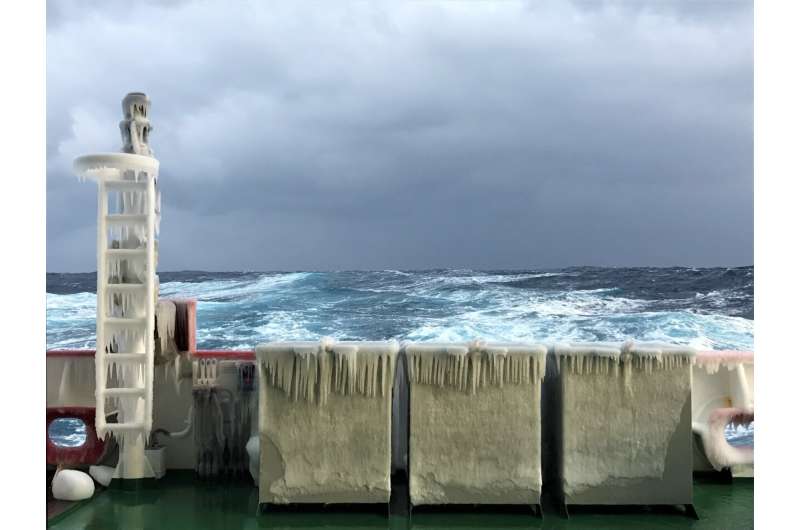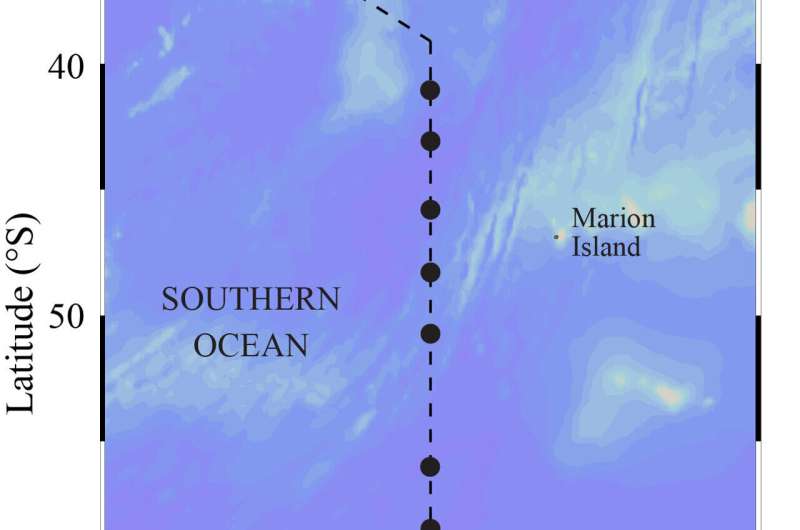The Southern Ocean's role in driving global carbon cycle stronger than expected
 During the July to August 2017 winter trip on board the SA Agulhas II polar research vessel, scientists from Stellenbosch University often had to endure high waves and icy conditions. Pictured here are icicles from the aft deck of the ship, with air temperature of minus 13°C (without wind chill). Credit: Ryan Cloete
During the July to August 2017 winter trip on board the SA Agulhas II polar research vessel, scientists from Stellenbosch University often had to endure high waves and icy conditions. Pictured here are icicles from the aft deck of the ship, with air temperature of minus 13°C (without wind chill). Credit: Ryan Cloete
The Southern Ocean's role in driving the global carbon cycle may be stronger than expected as the biological carbon pump is not "switched off" in winter as previously thought.
Based on the most comprehensive winter study to date, conducted in the Southern Ocean during July and August 2017, scientists from Stellenbosch University's Centre for Trace and Experimental Biogeochemistry (TracEx) in the Department of Earth Sciences were able to show that phytoplankton were indeed active during the icy cold and dark winter months.
These findings are important for predictive global climate models, which currently are based predominantly on spring and summer seasons. With the addition of data from winter, the models can now better represent the atmosphere-to-ocean carbon transfer cycle over seasons. For scientists, this is a step forward in analyzing the sensitivity of this transfer to climate change.
Phytoplankton are microscopic, single-celled plant-like organisms suspended mostly in the top 100 meters of the oceans. Using sunlight for energy and dissolved inorganic nutrients, phytoplankton convert carbon dioxide to organic carbon and form the base of the marine food web. It has been shown that phytoplankton are as important in modifying the planet's cycle of carbon and carbon dioxide as all the world's land plants combined.
Dr. Ryan Cloete, a postdoctoral fellow in the department and first author of two recent publications on the topic, says their findings are contrary to the general view that the Southern Ocean is biologically dormant during winter.
"Akin to leaves falling off trees during autumn because of unfavorable growth conditions, the assumption was that phytoplankton would also not be active during the winter. One of our major findings is that phytoplankton are indeed active during winter in the Southern Ocean, although not to the levels we see in summer. How phytoplankton are able to adapt to winter conditions is not well understood, and our research on trace nutrients is the first step in figuring out these adaption strategies," he explains.
To date, scientists have had very little understanding of the conditions that characterize the Southern Ocean during winter. This is mainly due to the challenge of sampling an ocean in sub-zero temperatures while bracing gale force winds and waves of up to 20 meters. It is not without reason that early sailors nicknamed this stretch of the Southern Ocean between latitudes 40° to 60° south the "Roaring Forties", following by the "Furious Fifties" and the "Screaming Sixties".
 The winter samples were collected on the SA Agulhas II, South Africa’s polar research vessel, during a South African-led expedition from July to August 2017. The sampling trip was funded by the South African National Antarctic Programme (SANAP), the Department of Forestry, Fisheries and the Environment (DFFE) and the National Research Foundation (NRF). Credit: Ryan Cloete
The winter samples were collected on the SA Agulhas II, South Africa’s polar research vessel, during a South African-led expedition from July to August 2017. The sampling trip was funded by the South African National Antarctic Programme (SANAP), the Department of Forestry, Fisheries and the Environment (DFFE) and the National Research Foundation (NRF). Credit: Ryan Cloete
Dr. Cloete says the Southern Ocean plays a fundamentally important role in regulating the earth's climate: "It is estimated to store about 75% of the global oceanic uptake of excess heat and 35% of the global uptake of excess carbon from the atmosphere. The Southern Ocean is also the only ocean that directly connects the three major ocean basins i.e. the Pacific, Atlantic and Indian Oceans. In other words, what happens in the Southern Ocean has an impact on the global ocean."
This global process is driven through a process called thermohaline circulation ('thermos' means heat and 'haline' means salinity). At the poles, the cold and dense surface seawater sinks to the deep ocean, from where it flows in large ocean currents to eventually return to the surface through mixing and wind-driven upwelling in the warmer latitudes. Scientists call this the great ocean conveyor belt, and it can take water almost a thousand years to complete the journey. The Southern Ocean therefore acts as a central hub whereby inflowing waters are modified and redistributed throughout the global ocean.
Dr. Cloete says the winter season in the Southern Ocean is extremely important for setting the biological stage for the spring and summer seasons: "In winter, strong storms and winds serve to create a more unstable surface layer which penetrates beneath the stable summer surface waters, which are now depleted in nutrients after the growing season. This allows mixing with the nutrient rich waters found in the sub-surface waters. With the help of increased sunlight hours and calmer seas, this winter pulse of nutrients to the surface helps catalyze and sustain spring and summer phytoplankton blooms which, in turn, attracts whales, dolphins and penguins to the Southern Ocean buffet from up north.
"Observing winter systems is helping us understand various adaptation and survival strategies of phytoplankton under adverse growth conditions as well as nutrient recharge processes in extreme nutrient depleted surface waters at the end of the summer season. This is extremely important as the Southern Ocean circulation hub dictates that these waters are transported northwards, influencing ocean productivity throughout much of the global low-latitude ocean," he explains.
Prof Alakendra Roychoudhury, a specialist in environmental and marine biogeochemistry at SU and head of the TracEx research group, says that the findings reaffirm the Southern Ocean's global influence in regulating the climate and the marine food web: "The earth system is intricately coupled through physical, chemical and biological processes with self-correcting feedback loops to modulate variability and negate climate change. Our research is a prime example of this coupling where biochemical processes happening at microscopic level at the interface of water and microorganisms, is influenced by large scale ocean circulation and mixing.
"It is hard to fathom that these microscopic processes can influence global processes like warming of our planet because often we lack the knowhow of the linked processes and their feedback response," he concludes.
The research was published in Marine Chemistry.
Explore further
More information: R. Cloete et al, Winter dissolved and particulate zinc in the Indian Sector of the Southern Ocean: Distribution and relation to major nutrients (GEOTRACES GIpr07 transect), Marine Chemistry (2021). DOI: 10.1016/j.marchem.2021.104031
Provided by Stellenbosch University South Africa
By accepting you will be accessing a service provided by a third-party external to https://oc3anclub.com/

